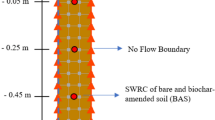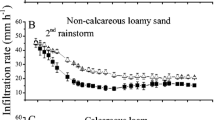Abstract
Due to climate change, extreme rainfalls happen more frequently with different patterns. Biochar and plant roots can affect soil water retention curve (SWRC) and hence slope stability. Until now, no available SWRC model considers soil–plant-biochar interaction, which can also be used for slope stability analysis under extreme rainfalls with different patterns (i.e., advanced, bimodal, and delayed). This study proposes a new SWRC model for vegetated biochar-amended soil by considering the influence of soil–plant-biochar interaction on the void ratio and pore structure. A series of numerical analyses were conducted to investigate the significance of new SWRC model on slope stability under extreme rainfall patterns. Good agreements between laboratory measurements and the new SWRC model predictions were obtained. With an increase of biochar content from 0 to 10%, the number of soil micropores increased by 22%, which improved root volume ratio (Rv) by 130% and hence air entry value (AEV) of vegetated soil by 50%. Based on numerical analysis, the factor of safety (FOS) for vegetated slope under advanced and bimodal rainfall patterns was up to 53% lower than that under the delayed one during rainfall. The rainfall influence depth and FOS of vegetated slope without biochar was nearly 100% deeper and 60% lower than that with biochar, respectively. The lowest FOS was caused by advanced rainfall pattern, which is therefore suggested for slope design. The application of 10% biochar can better stabilize shallow slopes due to its substantial effects on plant root, soil pore structure, and SWRC.











Similar content being viewed by others
References
Alonso EE, Pinyol NM, Gens A (2013) Compacted soil behaviour: initial state, structure and constitutive modelling. Geotechnique 63(6):463–478
ASTM (2010a) ASTM D2487: Standard practice for classification of soils for engineering purposes (Unified Soil Classification System). West Conshohocken, PA, USA: ASTM International
ASTM (2010b) ASTM D5084: Standard test methods for measurement of hydraulic conductivity of saturated porous materials using a flexible wall permeameter. West Conshohocken, PA, USA: ASTM International
Azevedo MCBD, Chopart JL, Medina CDC (2011) Sugarcane root length density and distribution from root intersection counting on a trench-profile. Sci Agr 68(1):94–101
Balzano B, Tarantino A, Ridley A (2019) Preliminary analysis on the impacts of the rhizosphere on occurrence of rainfall-induced shallow landslides. Landslides 16(10):1885–1901
Bai M, Wilske B, Buegger F, Esperschütz J, Kammann CI, Eckhardt C, Koestler M, Kraft P, Bach M, Frede H, Breuer L (2013) Degradation kinetics of biochar from pyrolysis and hydrothermal carbonization in temperate soils. Plant Soil 372(1):375–387
Brewer CE, Chuang VJ, Masiello CA, Gonnermann H, Gao X, Dugan B, Driver LE, Panzacchi P, Zygourakis K, Davies CA (2014) New approaches to measuring biochar density and porosity. Biomass Bioenerg 66:176–185
Chai YY, Sun X (2018) Analysis of rainstorm pattern and change trend in Shenzhen Basin. Tech Superv Water Res 6:140–142
Chen R, Huang JW, Chen ZK, Xu Y, Liu J, Ge YH (2019) Effect of Root Density of Wheat and Okra on Hydraulic Properties of an Unsaturated Compacted Loam. Eur J Soil Sci 70(3): 493–506
Chen R, Hung JW, Leung AK, Chen ZK, Chen ZB (2022) Experimental investigation on water release and gas emission of evapotranspirative capillary barrier landfill covers. Soil Sci Soc Am J 2022:1–13
Chen Y, Gao Y, Ng CWW (2020) A new capillary barrier system for retaining wall backfilled with fine-grained soil. Comput Geotech 118:103324
COMSOL (2020) COMSOL v5.6 Multiphysics Reference Manual. COMSOL Inc., Stockholm, Sweden
DSD (Drainage Services Department) (2013) Stormwater drainage manual. Hong Kong Government, Hong Kong
Feddes RA, Kowalik P, Kolinskamalinka K, Zaradny H (1976) Simulation of field water-uptake by plants using a soil-water dependent root extraction function. J Hydrol 31 (1–2):13–26
Gallipoli D, Wheeler SJ, Karstunen M (2003) Modelling the variation of degree of saturation in a deformable unsaturated soil. Géotechnique 53(1):105–112
Garg A (2015) Effects of vegetation types and characteristics on induced soil suction. PhD Thesis. The Hong Kong Univ Sci Tech, Hong Kong
GEO (Geotechnical Engineering Office) (2011) Technical guidelines on landscape treatment for slopes. Hong Kong, China: Geotech Eng Office
Geo-slope Ltd. (2008) Slope/W for slope stability analysis: user’s guide. GEO-SLOPE International Ltd., Calgary, Alberta, Canada.Ghani ANC, Taib AM, Hasbollah
Ghani ANC, Taib AM, Hasbollah DZA (2020) Effect of rainfall pattern on slope stability. In Geotech Sust Infrastruc Develop (pp. 887–892). Springer, Singapore
Ghestem M, Sidle RC, Stokes A (2011) The influence of plant root systems on subsurface flow: implications for slope stability. Bioscience 61(11):869–879
Jeffery S, Meinders MB, Stoof CR, Bezemer TM, van de Voorde TFJ, Mommer L, van Groenigen JW (2015) Biochar application does not improve the soil hydrological function of a sandy soil. Geoderma 251:47–54
Jung SH, Kim JS (2014) Production of biochars by intermediate pyrolysis and activated carbons from oak by three activation methods using CO2. J Anal Appl Pyrolysis 107:116–122
Kim J, Jeong S, Regueiro RA (2012) Instability of partially saturated soil slopes due to alteration of rainfall pattern. Eng Geol 147:28–36
Lamorski K, Šimůnek J, Sławiński C, Lamorska J (2017) An estimation of the main wetting branch of the soil water retention curve based on its main drying branch using the machine learning method. Water Resour Res 53(2):1539–1552
Lehmann J, Joseph SM (2009) Biochar for Environmental Management: Science and Technology. Routledge, New York, U.S.A
Liu Z, Dugan B, Masiello CA, Gonnermann HM (2017) Biochar particle size, shape, and porosity act together to influence soil water properties. Plos One 12(6):e0179079
Major J (2010) Guidelines on practical aspects of biochar application to field soil in various soil management systems. International Biochar Initiative 8:5–7
Moiwo JP, Wahab A, Kangoma E, Blango MM, Ngegba MP, Suluku R (2019) Effect of biochar application depth on crop productivity under tropical rainfed conditions. Appl Sci 9(13):2602
Nakhli SAA, Imhoff PT (2020) Models for predicting water retention in pyrogenic carbon (biochar) and biochar‐amended soil at low water contents. Water Resour Res 56(11):e2020WR027726
Ng CWW, Pang YW (2000) Influence of stress state on soil-water characteristics and slope stability. J Geotech Geoenviron Eng ASCE 126(2):157–166
Ng CWW, Wang B, Tung YK (2001) Three-dimensional numerical investigations of groundwater responses in an unsaturated slope subjected to various rainfall patterns. Can Geotech J 38(5):1049–1062
Ng CWW, Menzies B (2007) Advanced unsaturated soil mechanics and engineering Taylor and Franci New York
Ng CWW, Ni JJ, Leung AK, Wang ZJ (2016) A new and simple water retention model for root-permeated soils. Geotech Lett 6(1):106–111
Ni JJ, Chen XW, Ng CWW, Guo HW (2018a) Effects of biochar on water retention and matric suction of vegetated soil. Geotech Lett 8(2):124–129
Ni JJ, Leung AK, Ng CWW, Shao W (2018b) Modelling hydro-mechanical reinforcements of plants to slope stability. Comput Geotech 95:99–109
Ni JJ, Bordoloi S, Shao W, Garg A, Xu G, Sarmah AK (2020) Two-year evaluation of hydraulic properties of biochar-amended vegetated soil for application in landfill cover system. Sci Total Environ 712:136486
Ojuederie OB, Olanrewaju OS, Babalola OO (2019) Plant growth promoting rhizobacterial mitigation of drought stress in crop plants: implications for sustainable agriculture. Agronomy 9(11):712
Ouyang L, Wang F, Tang J, Yu L, Zhang R (2013) Effects of biochar amendment on soil aggregates and hydraulic properties. J Soil Sci Plant Nutr 13(4):991–1002
Otalvaro IF, Neto MPC, Delage P, Caicedo B (2016) Relationship between soil structure and water retention properties in a residual compacted soil. Eng Geol 205:73–80
Pietikäinen J, Kiikkilä O, Fritze H (2000) Charcoal as a habitat for microbes and its effect on the microbial community of the underlying humus. Oikos 89:231–242
Rahimi A, Rahardjo H, Leong EC (2011) Effect of antecedent rainfall patterns on rainfall-induced slope failure. J Geotech Geoenviron Eng ASCE 137(5):483–491
Rasband WS (2011) Image J. Bethesda, Maryland, USA: US National Institutes of Health
Razaq M, Shen HL, Sher H, Zhang P (2017) Influence of biochar and nitrogen on fine root morphology, physiology, and chemistry of Acer mono. Sci Rep-UK 7(1):1–11
Romero E, Gens A, Lloret A (1999) Water permeability, water retention and microstructure of unsaturated compacted boom clay. Eng Geol 54(1–2):117–127
Scholl P, Leitner D, Kammerer G, Lioskandl W, Kaul HP, Bodner G (2014) Root induced changes of effective 1D hydraulic properties in a soil column. Plant Soil 381(1–2):193–213
Song W, Guo M (2012) Quality variations of poultry litter biochar generated at different pyrolysis temperatures. J Anal Pyrol 94:138–145
Uzoma K, Inoue M, Andry H, Fujimaki H, Zahoor A, Nishihara E (2011) Effect of cow manure biochar on maize productivity under sandy soil condition. Soil Use Manage 27:205–212
Scanlan CA, Hinz C (2010) Insight into the processes and effects of root induced changes to soil hydraulic properties. Proceedings of the 19th World Congress of Soil Science, Soil Solutions for a Changing World, Brisbane, Australia. 2(41–44)
van Genuchten M (1980) A closed-form equation for predicting the hydraulic conductivity of unsaturated soils. Soil Sci Soc Am J 44:892–898
Vanapalli SK, Fredlund DG, Pufahl DE, Clifton AW (1996) Model for the prediction of shear strength with respect to soil suction. Can Geotech J 33(3):379–392
Wang L, Tang L, Wang Z, Liu H, Zhang W (2020) Probabilistic characterization of the soil-water retention curve and hydraulic conductivity and its application to slope reliability analysis. Comput Geotech 121:103460
Wong JTF, Chen Z, Chen X, Ng CWW, Wong MH (2017) Soil-water retention behavior of compacted biochar-amended clay: a novel landfill final cover material. J Soil Sediment 17:590–598
Xiang Y, Deng Q, Duan H, Guo Y (2017) Effects of biochar application on root traits: a meta-analysis. GCB Bioenergy 9(10):1563–1572
Xing X, Li Y, Ma X (2018) Water retention curve correction using changes in bulk density during data collection. Eng Geol 233:231–237
Xing X, Liu Y, Garg A, Ma X, Yang T, Zhao L (2021) An improved genetic algorithm for determining modified water-retention model for biochar-amended soil. Catena 200:105143
Yi S, Chang NY, Imhoff PT (2020) Predicting water retention of biochar-amended soil from independent measurements of biochar and soil properties. Adv Water Resour 142:103638
Yu H, Zou W, Chen J, Chen H, Yu Z, Huang J, Tang H, Wei X, Gao B (2019) Biochar amendment improves crop production in problem soils: areview. J Environ Manage 232:8–21
Zhang LL, Zhang J, Zhang LM, Tang WH (2011) Stability analysis of rainfall-induced slope failure: a review. P i Civil Eng-Geotec 164(5):299–316
Zhou C, Chen R (2021) Modelling the Water Retention behaviour of Anisotropic Soils. J Hydrol 599:126361
Zhou C, Ng CWW (2014) A new and simple stress-dependent water retention model for unsaturated soil. Comput Geotech 62:216–222
Zong Y, Xiao Q, Lu S (2016) Acidity, water retention, and mechanical physical quality of a strongly acidic Ultisol amended with biochars derived from different feedstocks. J Soil Sediment 16(1):177–190
Acknowledgements
The authors would like to thank the financial sponsorship from the National Natural Science Foundation of China (U20A20320, 51778166 and 51808171) and the Natural Science Foundation of Guangdong Province (2018A030310018) and supports from the area of excellence project (AoE/E-603/18) provided by the Research Grants Council of HKSAR and Environment and Conservation Fund (ECWW19EG01). Mr. Zhang Qi is grateful for the support of the Hong Kong PhD Fellowship Scheme (HKPFS) provided by the RGC of the HKSAR.
Author information
Authors and Affiliations
Corresponding author
Ethics declarations
Conflict of interest
The authors declare no competing interests.
Rights and permissions
About this article
Cite this article
NG, C.W.W., GUO, H., NI, J. et al. Effects of soil–plant-biochar interactions on water retention and slope stability under various rainfall patterns. Landslides 19, 1379–1390 (2022). https://doi.org/10.1007/s10346-022-01874-y
Received:
Accepted:
Published:
Issue Date:
DOI: https://doi.org/10.1007/s10346-022-01874-y




